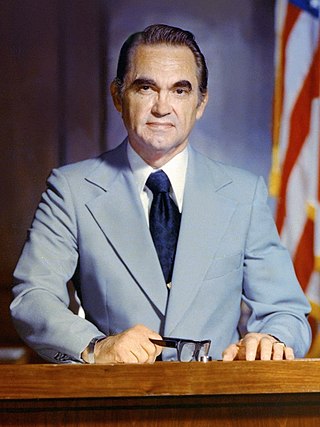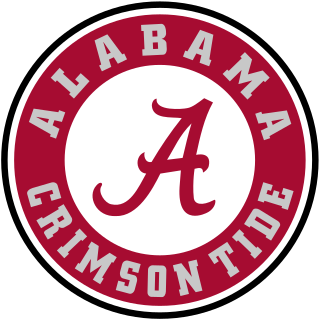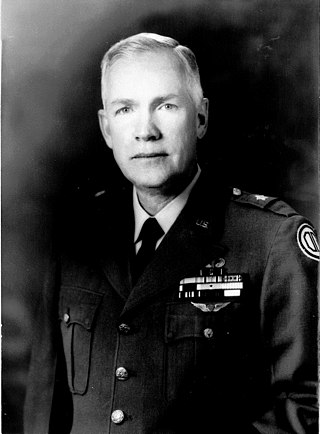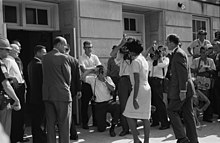
Tuscaloosa County is a county in the northwest-central portion of the U.S. state of Alabama and is the center of commerce, education, industry, health care, and entertainment for the region.

Tuscaloosa is a city in and the seat of Tuscaloosa County in west-central Alabama, United States, on the Black Warrior River where the Gulf Coastal and Piedmont plains meet. Alabama's fifth-most populous city. The population was 99,600 at the 2020 census, and was estimated to be 110,602 in 2022. It was known as Tuskaloosa until the early 20th century. It is also known as "the Druid City" because of the numerous water oaks planted in its downtown streets since the 1840s.

George Corley Wallace Jr. was an American politician and judge who served as the 45th governor of Alabama for four terms. He is remembered for his staunch segregationist and populist views. During Wallace's tenure as governor of Alabama, he promoted "industrial development, low taxes, and trade schools." Wallace sought the United States presidency as a Democratic Party candidate three times, and once as an American Independent Party candidate, being unsuccessful each time. Wallace opposed desegregation and supported the policies of "Jim Crow" during the Civil Rights Movement, declaring in his 1963 inaugural address that he stood for "segregation now, segregation tomorrow, segregation forever."

The University of Alabama is a public research university in Tuscaloosa, Alabama. Established in 1820 and opened to students in 1831, the University of Alabama is the oldest and largest of the public universities in Alabama as well as the University of Alabama System. It is classified among "R1: Doctoral Universities – Very high research activity".

James Alexander Hood was one of the first African Americans to enroll at the University of Alabama in 1963, and was made famous when Alabama Governor George Wallace attempted to block him and fellow student Vivian Malone from enrolling at the then all-white university, an incident which became known as the "Stand in the Schoolhouse Door".

Bryant–Denny Stadium is an outdoor stadium in the southeastern United States, on the campus of the University of Alabama in Tuscaloosa. It is the home field of the Alabama Crimson Tide football team of the Southeastern Conference (SEC).

Alabama Agricultural and Mechanical University is a public historically black land-grant university in Normal, Huntsville, Alabama. Founded in 1875, it took its present name in 1969. It was one of about 180 "normal schools" founded by state governments in the 19th century to train teachers for the rapidly growing public common schools. It was one of 23 established to train African Americans to teach in segregated schools. Some closed but most steadily expanded their role and became state colleges in the early 20th century and state universities in the late 20th century. AAMU is a member-school of the Thurgood Marshall College Fund and is accredited by the Southern Association of Colleges and Schools. Alabama Agricultural and Mechanical University Historic District, also known as Normal Hill College Historic District, has 28 buildings and four structures listed in the United States National Register of Historic Places.

Stillman College is a private historically black Presbyterian college in Tuscaloosa, Alabama. It awards Bachelor of Arts and Bachelor of Science degrees in 22 programs housed within three academic schools. The college has an average enrollment of 728 students and is accredited by the Southern Association of Colleges and Schools.

The University of Alabama, the state's oldest continuously public university, is a senior comprehensive doctoral-level institution located in Tuscaloosa, Alabama.

The Alabama Crimson Tide refers to the intercollegiate athletic varsity teams that represent the University of Alabama, located in Tuscaloosa. The Crimson Tide teams compete in the National Collegiate Athletic Association's Division I as a member of the Southeastern Conference (SEC). The Spirit Squads compete in the UCA and UDA College National Championships.

Coleman Coliseum is a 15,383-seat multi-purpose arena in Tuscaloosa, Alabama, on the campus of the University of Alabama. It is the current home of the Alabama Crimson Tide men's and women's basketball and women's gymnastics teams, and previously served as the home of the women's volleyball program. Opened in 1968 as Memorial Coliseum as a replacement for Foster Auditorium, the coliseum is located at the center of the University of Alabama's athletic complex, which also includes Sewell-Thomas Stadium, Sam Bailey Track & Field Stadium, the Hank Crisp Indoor Facility, the Mal M. Moore Athletic Facility and the football building and practice fields.

The University of West Alabama (UWA) is a public university in Livingston, Alabama. Founded in 1835, the school began as a church-supported school for young women called Livingston Female Academy. The original Board of Trustees of Livingston Female Academy was selected in 1836, and four of the seven board members were Presbyterians.

Vivian Juanita Malone Jones was one of the first two black students to enroll at the University of Alabama in 1963, and in 1965 became the university's first black graduate. She was made famous when George Wallace, the Governor of Alabama, attempted to block her and James Hood from enrolling at the all-white university.

Autherine Juanita Lucy was an American activist who was the first African-American student to attend the University of Alabama, in 1956. Her expulsion from the institution later that year led to the university's President Oliver Carmichael's resignation. Years later, the University admitted her as a master's student and in 2010 a clock tower was erected in her honor on its campus.

The Alabama Crimson Tide men's basketball team represents the University of Alabama in NCAA Division I men's basketball. The program plays in the Southeastern Conference (SEC). In the conference it trails only long-time basketball powerhouse Kentucky in SEC tournament titles, is third behind Kentucky and Arkansas in total wins, and is third behind Kentucky and Tennessee in SEC regular season conference titles. Alabama was retroactively recognized as the pre-NCAA tournament national champion for the 1929–30 season by the Premo-Porretta Power Poll. The team has appeared in the NCAA tournament 24 times, most recently in 2024, and has made ten Sweet Sixteens, two Elite Eights, and one Final Four in the tournament. Alabama's current head coach is Nate Oats.

Henry Vance Graham was an American Army National Guard general who protected black activists during the Civil Rights Movement. He is most famous for asking Alabama governor George Wallace to step aside and permit black students to register for classes at the University of Alabama in Tuscaloosa in 1963 during the "Stand in the Schoolhouse Door" incident.

The Stand in the Schoolhouse Door took place at Foster Auditorium at the University of Alabama on June 11, 1963. George Wallace, the Governor of Alabama, in a symbolic attempt to keep his inaugural promise of "segregation now, segregation tomorrow, segregation forever" and stop the desegregation of schools, stood at the door of the auditorium as if to block the entry of two African American students: Vivian Malone and James Hood.
Crisis: Behind a Presidential Commitment is a 1963 direct cinema documentary film directed by Robert Drew. The film centers on the University of Alabama's "Stand in the Schoolhouse Door" integration crisis of June 1963. Drew and the other filmmakers, including D. A. Pennebaker and Richard Leacock, were given expanded access to key areas, including United States President John F. Kennedy's Oval Office and the homes of United States Attorney General Robert F. Kennedy and Governor George Wallace of Alabama. The film first aired on the American Broadcasting Company (ABC) as an installment of Close-Up! four months after the incident, on October 28, 1963. It was added to the National Film Registry of the Library of Congress on December 28, 2011.

Frank Anthony Rose was an American academic, formerly a president of the University of Alabama.
Little Hall is a historic building on the campus of the University of Alabama at Tuscaloosa, Alabama. It was built in 1915 and designed by Frank Lockwood of Montgomery as the university's first stand-alone gymnasium. The gymnasium was named for William Gray "Bill" Little (1873–1938), the student credited with introducing football to the university. It was in use by the Alabama Crimson Tide men's basketball from 1915 to 1939, when Foster Auditorium opened nearby. The gym received an expansion in 1935, and has been converted twice; once in the 1950s for the School of Nursing, and again in 1967 to host the School of Social Work, its current tenant.






















